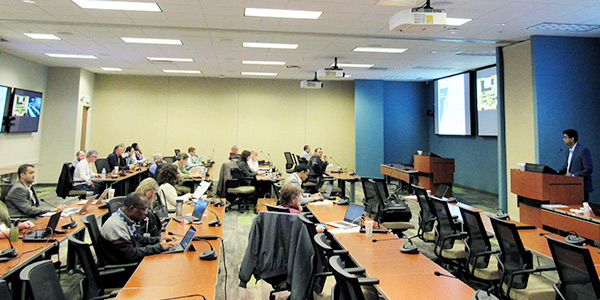MISO will allow stakeholders an additional month to file their opinions on the RTO’s draft 2021 transmission planning futures scenarios.
The three futures have undergone three sets of alterations as MISO evaluates and responds to stakeholder requests. (See MISO Outlines Electrifying Tx Planning Futures.) The RTO had hoped to finalize new scenarios in April.
Speaking during a Planning Advisory Committee conference call Wednesday, Planning Manager Tony Hunziker said MISO will now collect stakeholders’ written feedback through March 27 and hold more discussion at the PAC’s April meeting.
Future I — formerly Announced Plans — assumes an 85% probability that companies’ renewable growth and carbon-cutting goals will materialize and full certainty that states’ clean energy plans will come to pass. It also includes a 40% reduction in carbon emissions from 2005 levels by 2040.
Future II — previously Accelerated Fleet Change — assumes MISO members meet or exceed decarbonization plans while carbon emissions drop 60% from 2005 levels. Electric vehicle adoption stimulates demand, while residential and commercial electrification reaches 39% of its technical potential, representing a 30% energy growth footprint-wide by 2040.
Future III — Advanced Electrification — also assumes members fulfill their renewable plans and consumers adopt EVs. It foresees a sharp increase in demand because of residential and commercial electrification hitting 77% of its technical potential, representing a 60% energy growth. MISO also experiences a minimum 50% renewable penetration level as carbon emissions dip 80% below 2005 levels.
From its last futures draft, MISO has eliminated the nearly 35% renewable generation minimum penetration by 2040 prediction in Future I. The RTO’s most aggressive renewable prediction in the MTEP 19 futures estimated that renewables would take a 36% share of the resource mix by 2035.

Consultant Kavita Maini said it didn’t appear MISO was preparing for the possibility of an economic slowdown and a subsequent postponement of the retirement of certain plants in an effort to keep investments and customer rates low. She said some utilities might not achieve the emissions reductions for which MISO is planning.
“I don’t think we want to plan for doomsday,” Minnesota Public Utilities Commission staff member Hwikwon Ham responded, noting that MISO plans for an average growth, not the troughs and booms of the economy.
“Regardless of your political leanings, I can guarantee there’s going to be at least one administration”, that changes party, MISO Planning Manager Tony Hunziker said.
The futures are set to guide the 2021 MISO Transmission Expansion Plan (MTEP 21). MISO will begin planning for MTEP 2022 in June.
The RTO has also scheduled an April 16 workshop to discuss resource siting for the MTEP 2021 futures.
PAC to Begin MTEP, Queue Synchronization
MISO members will soon decide whether to retire the Coordinated Planning Process Task Team (CPPTT), charged with compiling ideas for synchronizing the annual transmission expansion plan with interconnection project planning.
The CPPTT’s sole purpose was to review the MTEP and generation interconnection planning processes and identify ways the RTO could increase consistency and coordination across the two. The team forwarded its findings to the PAC and Planning Subcommittee. (See MISO Committees Tackle Queue, Tx Planning Disparities.)
MISO Senior Manager of Economic Planning Neil Shah said having created the list of issues, stakeholders could decide to retire the CPPTT if there are no additional assignments for the group.
Shah said once reliability, economic and interconnection queue planning processes are synched up, MISO could identify fewer and more cost-effective transmission projects.
“We can evaluate a single solution instead of three separate solutions using three different processes,” Shah said. “If the timing is not aligned, there isn’t much opportunity to share information and evaluate.”
Some stakeholders asked that MISO either draft a white paper or hold workshops before drafting solution ideas in the PAC.
Stakeholders will again discuss the issue at the April PAC meeting.
Retiring Coal Plants Prompt Expedited MTEP 20 Projects
MISO is recommending that two substation bypass projects begin earlier than the MTEP 20 cycle allows, stakeholders heard.
The RTO received two expedited project review requests from Ameren in December to bypass the 345-kV Coffeen and Duck Creek substations in western Illinois. Ameren said the projects are necessary because Vistra Energy has retired the corresponding Coffeen and Duck Creek power plants, which used to be pseudo-tied into PJM.
MISO said the bypass projects will “eliminate the need for AC/DC station service at these stations since these services became inefficient due to the retirements.” The RTO also said it didn’t discover any reliability issues as a result of the projects.
Ameren said it will save about $1.5 million if it no longer has to provide AC/DC station service or oversee the operations and maintenance costs of the substations.
MISO said it will move both projects into Appendix A of MTEP 20 and authorized Ameren to begin construction.
— Amanda Durish Cook



